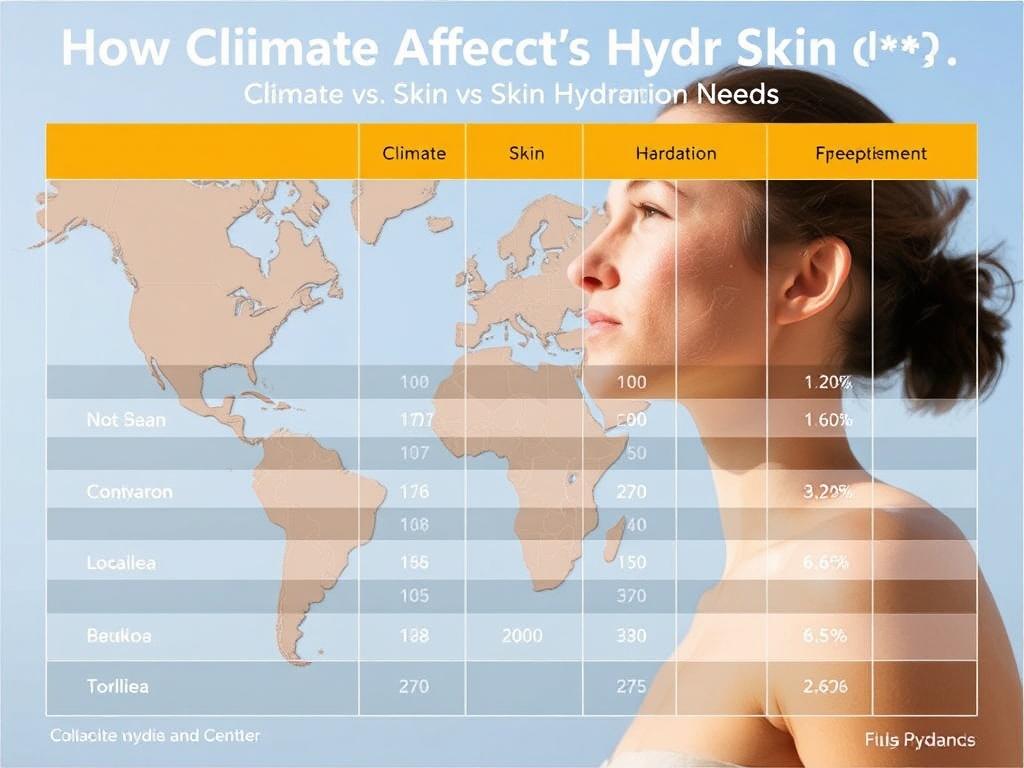Содержание статьи
- 1 The Science of Skin Hydration
- 2 How Different Climates Impact Your Skin’s Hydration Needs
- 3 Adapting Your Skincare Routine Based on Climate
- 4 Traveling and Skin Hydration: What You Need to Know
- 5 Common Skin Hydration Mistakes and How to Avoid Them
- 6 Myths About Climate and Skin Hydration
- 7 Summary Table: Climate vs. Skin Hydration Needs
- 8 Conclusion
When it comes to taking care of your skin, one size does not fit all. You might have noticed that your skin’s hydration needs change with the seasons or when you travel to different places. That’s because climate plays a major role in how your skin behaves, and understanding this connection can make a big difference in achieving healthy, glowing skin. Whether you’re battling dry, flaky skin in the winter or struggling with excess oil and dehydration in the humid summer, knowing how climate affects your skin’s hydration needs is the key to customizing your skincare routine for every environment.
In this article, we’ll explore the science behind skin hydration and climate, explain how different weather patterns and environments impact your skin, and provide practical tips to adjust your skincare accordingly. By the time you finish reading, you’ll be equipped with everything you need to keep your skin nourished, balanced, and radiant no matter where you live or travel.
The Science of Skin Hydration
Before diving into the impact of climate, it’s important to understand how hydration works in your skin. Your skin is your body’s largest organ, and it depends on water to stay healthy, plump, and elastic. Beneath the surface, skin cells hold water, which forms a barrier against external aggressors like pollution and UV rays. This barrier also protects your skin from losing moisture to the environment. When your skin loses too much water, it becomes dry, tight, and more prone to irritation and wrinkles.
Your skin’s ability to retain water comes largely from its natural moisturizing factors (NMFs) and a lipid (oil) barrier on the outermost layer, known as the stratum corneum. These components work together to prevent transepidermal water loss (TEWL). But climate factors like temperature, humidity, wind, and sun exposure can disrupt this balance significantly.
How Temperature and Humidity Affect Skin Hydration
Temperature influences how much moisture your skin loses. In cold weather, the air is typically drier, which sucks moisture from your skin faster. Low humidity levels mean the atmosphere doesn’t have enough water vapor, so the rate of evaporation from your skin speeds up, leading to dry, flaky skin.
On the other hand, hot and humid climates cause your skin to sweat more. Sweat can make your skin feel oily, but paradoxically, this does not always mean your skin is properly hydrated. Sweat evaporates to cool your body, which can also take moisture away from your skin if not properly managed. In tropical or humid conditions, your skin may feel greasy but can still be dehydrated because the water content inside skin cells is low despite the external moisture.
The Role of Wind and Sun Exposure
Wind is another enemy of skin hydration. When windy, especially in colder months, it strips the skin of its natural oils and moisture, accelerating water loss. This is why your skin often feels rough and chapped after a windy day outdoors. Chapped lips and red, irritated cheeks are common results of prolonged wind exposure combined with dry air.
Sun exposure adds another layer of complexity. Ultraviolet (UV) rays break down collagen and elastin — vital structural components in skin — and also interfere with the skin’s barrier function. UV damage increases transepidermal water loss, causing dehydration even if your skin looks oily or sweaty on the surface. The sun also thickens the outer skin layer, which can make skin feel dry and rough over time if hydration is not maintained.
How Different Climates Impact Your Skin’s Hydration Needs
Different geographical environments bring unique challenges and needs when it comes to skin hydration. Let’s break down the effects of various climates on your skin and what that means for your hydration strategy.
1. Cold and Dry Climates
Cold winter climates, especially those in northern latitudes or high altitudes, tend to be dry with low humidity. This combination is especially harsh on skin because:
- Cold air holds less moisture, causing rapid drying.
- Indoor heating further reduces humidity, compounding dryness.
- Wind exposure intensifies moisture loss.
In cold and dry climates, your skin needs a heavier, more emollient moisturizer to help restore the lipid barrier. Products containing occlusives like petrolatum, shea butter, or oils can lock in moisture effectively. Avoid cleansers that strip natural oils, and consider using a humidifier indoors to add moisture to the air.
2. Hot and Humid Climates
Tropical and subtropical regions with high heat and humidity present a different set of challenges:
- Increased sweating can mix with sebum and clog pores.
- Humidity slows down water evaporation, but skin can still feel dehydrated.
- Heat stimulates oil production, leading some to skip moisturizers altogether.
Despite the oily feeling, hot and humid climates still demand hydration. Choose lightweight, water-based moisturizers that won’t clog pores but help replenish moisture inside skin cells. Products with humectants like glycerin and hyaluronic acid can attract and hold water. Plus, regular cleansing is essential to remove sweat and impurities that block pores.
3. Dry and Arid Climates
Desert areas and places with very low humidity have dry air that steals moisture quickly. Sun intensity is often high, increasing skin damage:
- Rapid skin dehydration from dryness and sun exposure.
- Poor water retention due to weak lipid barriers from lack of moisture.
- More frequent sensitivity and irritation.
In arid climates, intensive hydration combined with sun protection is vital. Using moisturizers rich in ceramides and occlusive agents can create a shield to reduce water loss. Sunscreens with moisturizing properties help protect from UV damage and dryness simultaneously.
4. Temperate and Mild Climates
Regions with mild weather and moderate humidity usually allow skin to maintain hydration fairly well naturally. However:
- Fluctuations between seasons still affect hydration needs.
- Air pollution might impact the skin barrier.
- Transition seasons (spring and fall) can bring dryness or oiliness.
Adjust your skincare seasonally by using lighter moisturizers in summer and richer creams in winter. Regular exfoliation helps maintain a healthy barrier for better hydration.
Adapting Your Skincare Routine Based on Climate
Now that we understand how climate conditions impact hydration, let’s talk about how to tailor your skincare routine to meet those specific needs.
Key Ingredients to Look For
| Ingredient | Function | Best For Climate(s) |
|---|---|---|
| Hyaluronic Acid | Powerful humectant; draws water into the skin | All climates, especially humid and temperate |
| Glycerin | Humectant that traps moisture | Humid, temperate, and some dry climates |
| Ceramides | Restore and strengthen skin barrier | Cold, dry, and arid climates |
| Shea Butter | Occlusive moisturizer; seals in hydration | Cold and dry climates |
| Petrolatum (Vaseline) | Occlusive that prevents water loss | Extremely dry and windy conditions |
| Niacinamide | Improves skin barrier and hydration | All climates |
| Aloe Vera | Soothes and hydrates sensitive, sun-exposed skin | Humid, hot, and arid climates |
Daily Skincare Tips for Every Climate
- Cleanse Gently: Use a mild, hydrating cleanser that won’t strip natural oils. Avoid harsh soaps especially in dry climates where skin is already vulnerable.
- Moisturize According to Need: Choose products suited to your environment. Heavier creams in the winter or dry areas, and lightweight gels for humid zones.
- Never Skip Sunscreen: UV damage dehydrates skin and accelerates aging, so use broad-spectrum sunscreen every day, rain or shine.
- Hydrate Internally: Drink plenty of water to support skin hydration from the inside out. Consider herbal teas or infused water if plain water feels monotonous.
- Use a Humidifier: At home, especially in winter or dry climates, humidifiers can restore moisture to dry indoor air.
- Adjust Routine Seasonally: Your skin changes with the climate, so tweak your products and steps as the seasons change.
Traveling and Skin Hydration: What You Need to Know

Traveling exposes your skin to abrupt climate changes, which can cause dehydration and sensitivity. Airplane cabins are famously dry, with humidity levels as low as 20%, which accelerates moisture loss. When traveling:
- Bring a travel-sized hydrating mist or toner with humectants to refresh your skin.
- Pack moisturizer tailored to your destination’s climate.
- Drink more water than usual and avoid alcohol or caffeine, which can dehydrate you.
- Protect your skin from sun even on cloudy days or at high altitudes.
Common Skin Hydration Mistakes and How to Avoid Them
Many people underhydrate their skin without realizing it. Here are frequent mistakes to watch for:
- Using the Same Skincare Year-Round: Your skin’s needs shift with climate; ignoring this leads to persistent dryness or oiliness.
- Over-Cleansing: Washing your skin too often or with harsh products removes oils, weakening the moisture barrier.
- Skipping Moisturizer for Oily Skin: Even oily skin needs hydration; skipping moisturizer can trick skin into producing more oil.
- Ignoring Indoor Climate: Heated and air-conditioned environments can be just as drying as outdoor climate.
Myths About Climate and Skin Hydration

Let’s debunk a few popular myths that might confuse your skincare choices:
Myth #1: Oily skin doesn’t need moisturizer.
Even oily skin can become dehydrated. Moisturizers regulate oil production by keeping the skin balanced. Without hydration, oily skin can become even oilier to compensate.
Myth #2: You only need sunscreen on sunny days.
UV rays penetrate clouds and windows, causing dehydration and damage all year round. Broad-spectrum sunscreen is a must every day.
Myth #3: Drinking water alone hydrates your skin enough.
While hydration starts inside, topical hydration is equally important to seal moisture in and protect the skin barrier.
Myth #4: Natural oils and butters clog pores and should be avoided.
Not all oils clog pores. Lightweight, non-comedogenic oils like jojoba and squalane can actually nourish and protect your skin’s hydration barrier.
Summary Table: Climate vs. Skin Hydration Needs

| Climate | Skin Hydration Challenge | Recommended Skincare Approach | Key Ingredients |
|---|---|---|---|
| Cold & Dry | Rapid moisture loss, barrier damage | Heavy moisturizers, humidifier, gentle cleansing | Shea butter, ceramides, petrolatum |
| Hot & Humid | Oily, clogged pores, dehydrated cells | Lightweight gels, regular cleansing, hydration boost | Hyaluronic acid, glycerin, aloe vera |
| Dry & Arid | Dehydration, sun damage, sensitivity | Sun protection, barrier repair, occlusives | Ceramides, petrolatum, niacinamide |
| Temperate & Mild | Seasonal fluctuation, pollution effects | Seasonal product adjustments, pollution shields | Niacinamide, hyaluronic acid |
Conclusion
Understanding how climate affects your skin’s hydration needs empowers you to take better care of your skin year-round. From icy winds to tropical humidity, your skin adapts constantly, and your skincare routine should, too. By recognizing the unique challenges posed by different climates and adjusting your products and habits accordingly, you can prevent dryness, irritation, dehydration, and premature aging. Remember to hydrate both inside and out, protect your skin from sun damage, and listen to your skin’s signals as the seasons and environments change. With this knowledge, you’ll be able to maintain a healthy moisture balance and enjoy vibrant skin no matter where life takes you.

